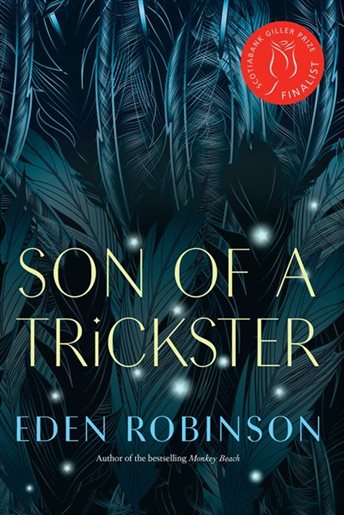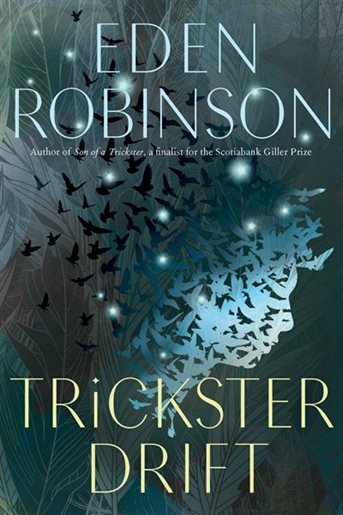
Embracing the Gonzo Moments: An Interview with Eden Robinson
- Posted by Augur Blog
- On December 5, 2018
- 0 Comments
- author interview, Eden Robinson, son of a trickster
In case you haven’t heard of Eden Robinson (but really, where have you been), she is an award-winning Haisla and Heiltsuk author of beloved books such as Monkey Beach, Traplines, and more recently, the Trickster series—a literary urban fantasy trilogy beginning with the Giller-shortlisted Son of a Trickster.
The sequel, Trickster Drift, shortlisted for the 2018 Sunburst Award, continues the tradition of the complicating teenage Jared’s life with out-of-the-blue appearances of magic from Indigenous myth.
Between bouts of infection laughter, Augur caught up with Robinson over the phone to chat about writing in the wee hours of the morning, dealing with unruly characters, and pairing gritty realism with fantasy.
Warning: small spoilers ahead!


Son of a Trickster was your first dive back onto the literary scene after almost a decade. How did you approach writing this trilogy compared to your other books?
This time around it took a while for me to warm up to writing because I haven’t been regularly writing for such a long time. I had this idea and I didn’t have a lot of time to write. I had between 4 a.m. and 5 a.m. free, so I could either write then for an hour or I could not write at all. It took a while for to get used to writing in those hours. Coffee is your friend. Well once you get used to it, it’s fine. I tend to write every day. I had a lot of personal and professional obligations at the time so that kind of regular writing I had to build it back up. First with ten minutes, then fifteen, and then get myself to be able to write for an hour. I’m easily distracted so I had to shut off Facebook, Netflix, HBO. Oh my goodness. [Laughs] I am going to start writing the third novel in December, so I’m just going to binge watch everything right now.
Was there anything that surprised you while writing these books compared to your previous books?
All of the other books were written at night and are very, very serious. Because all of these books in the trilogy were written so early in the day, they seem to have a goofier sense of humour. They’re still dark, you know, they still have their sombre moments, but there are also pretty gonzo moments where I was thinking, “Well, yeah, that will never make it past editing.” It was a lot of fun, I really enjoyed it. You know, I’m the kind of writer that if my characters are crying, I’m probably crying.
In the second novel, I knew the world a little bit more, but it still had a lot of twists I wasn’t expecting. The characters took a lot of turns where I just had to go, “Oh, okay, I guess that’s happening now…” I highly recommend writing early in the morning. [Laughs] Your inner editor is still asleep. Anything goes.
There was one moment pretty early in the book (Trickster Drift) where Jared realizes that Dent is a ghost and is trying to get him out of the apartment. I was just expecting one or two lines thrown into this goofy scene where he tried to use some sage spice and that led to a chapter I wasn’t expecting where he goes around and getting ingredients and a lot of that wander didn’t make it into the book, but writing the little bits was amazing and wonderful.
The Trickster, Wee’git, is an old, familiar character in Haisla/Heitsuk oral storytelling. What was it like to bring him onto the written page and onto the streets of modern-day Kitamaat?
In traditional stories, he wasn’t a bad guy he was just incredibly lazy and selfish. You know, he wasn’t out to hurt you, it was just a side effect of something he did and he usually got payback. In the books we get the Trickster as a transforming raven and he has a lot of different roles traditionally. The one I was mostly interested in was the one where he is just sort of popping up throughout the world and bumping into people.
You know, when you are connected to something magically it is kind of quantum mechanical—you are connected forever! So you keep recycling the same family over and over again. That also happens with Jared’s family. The Trickster has been connected with the witches in the family forever and I started to explore that a little more. What it means in the context of recent history and the present. Mostly it means fighting with Jared’s mom and his gran. [Laughs] And what does that mean for Jared. He’s not quite his dad.
Tricksters are generally irritating but Jared’s irritating in completely his own way. He wants everyone to get along. He’s bumping into all these magical creatures, like the otters. He’s very into AA right now so he is all about, “Let’s put all the cards on the table and work this out.” And they’re not on the same page. They would rather kill him. So it’s a lot of fun then. I like it when all the weird ideas sort of bump up against each other.
Your writing often combines gritty realism with fantasy. How do the two genres enable each other in your work?
They mesh together really well, with a lot of editing. Sometimes I will whiplash my characters. They would be part of a horrible, horrible scene during the day and then “Yay, magic!” It takes a bit of seguing to get them to work, but in my head they are a part and parcel of the world. There’re amazing things happening right now—and, you know, there’s less amazing things (e.g. whales choking to death on plastic side-by-side with discoveries of super-Earths)—and I think that’s just how the world works.
The first instances of magic in the book are so slight you might blink and miss them. Magic is really not confronted by any of the characters until the end of the book. How did you choose the right moments to introduce the fantastical into the story?
The moments—because it is so gritty—had to work with the world; they had to work with the character. I had introduced magic pretty heavily into the first draft, but it wasn’t hitting the right tone because Jared would have to ignore a lot. So me and my editor tuned it down and built it in slowly. And that makes a little more sense because, you know, he’s a little oblivious to magic so having him become aware of it slowly also helped introduce that element to the world.
Jared is not only haunted by the spirit world, the recent past is also a ghostly presence in the story. Granny Nita, for example, is a survivor of residential school and a very questionable TB sanitorium. Jared grows up as the Kitamaat economic fallout begins. How did the past influence the narrative?
It was a part of the characters and their world. I didn’t want it to overwhelm the narrative but it served as a sort of anchor. This is the world they came from; it’s reflecting a lot of the economic uncertainty I was seeing as I was writing. A lot of the things that were coming out about prevatoriums and the amount of experimentation that was done in them. And I felt that would be part of the world that Jared is inhabiting and would explain a lot of the fissures in his belief system. He didn’t grow up knowing it and learning about it. It was an interesting journey for him.
I knew that Granny Nita’s experience had to be extreme for her to become the kind of extreme person that she is. In the third book we meet her sister and by then we’ve heard about Nita’s experience in the TB sanitorium and residential school, but we haven’t heard about her moments of realization that magic was in her world and that is what her sister brings to the story. So we delve into that relationship more and why the family butts heads with her.
In the acknowledgements to Son of a Trickster, you describe the internal world of the book as having “no logic.” And in fact the story is full of disruptions. There is violence, dysfunctional family members, unreliable friends, drugs and alcohol and let’s not forget the spirits. What drew you to writing these moments of dysfunction?
I don’t have a linear, logical mind anyways. So it was super hard to get anything out of me that would be simple. In the beginning, when I was struggling with structure my editor suggested that because there were so many different, diverse elements that maybe we should simplify the structure to be more linear. That was kind of monumental for me!
I think there were, maybe, two short stories which were more or less linear but I haven’t written a novel like that. Once it became a more traditional, linear story then it started flowing again and it was a great suggestion. But all the other elements, when they’re going gonzo, when I’m first writing them down I just let them come. If I start editing in the first draft then it gums up and breaks up the work, then I start editing as I write and it goes really slowly. You need to get the gonzo scenes down first.
Even on the level of dialogue Maggie’s (Jared’s mom) sarcastic swearing (which is its own art form) cuts through the narration. Why did you write her that way?
Oh, my god! Well, she was supposed to be just a background character, to just show up and leave, disappear into one of her drug weekends. She just hung around and I was thinking, “Okay, well I don’t really know what she’s doing.” But her and Jared had such lovely banter, so much fun, and I didn’t really want her to leave. They had these odd moments of tenderness and they had all these moments where they’ve been so much together that they had a linguistic shorthand that was just a delight to work with. I think it would be kind of horrible, personally, but as a writer it was rich. She is an offstage presence in Trickster Drift but she’s still there and making her usual comments.
I love the way her insecurities bounce off her insecurities. Because they had so much at stake, because they had so much invested in each other they were constantly bouncing off each other. It makes for wonderful characters even though that would probably not be an ideal relationship.
The novels contain a variety of Indigenous voices. Some characters embrace their culture in its many forms, some engage in political conversations and activists for their people, and yet others, like Jared, often resist it. How do they reflect the Indigenous voices of your community, as you see them?
The characters are part of the same spectrum. We have activists, we have very political people and, you know, we have very traditional people and we have people who just want to pay the bills. And I think Jared definitely falls into the “I just want to pay the bills” category. He’s been broke most of his life, but he’s looking for his economic security. His entire goal is to have a very quiet life. He’s had enough chaos.
Whereas other characters, their goal is a connection with their community. I just wanted to have a world where all the Indigenous characters were diverse, where they had their own agendas, where they went about things differently because that is what I see.
Yeah, Jared’s a little politically vacant. [Laughs] He’s hilarious. He has his own way of thinking. He expects everyone to think the same way and when they don’t he’s surprised. Okay, dude. Yeah, that doesn’t serve him well with the next batch of supernatural creatures. He definitely doesn’t do what people expect.
What would you like to see more of in Canadian & Indigenous speculative fiction?
I would like to see a kind of broadening [of the genre]. Cherie Demaline and Waubgeshig Rice—they’ve stepped in and wrote apocalypses from an Indigenous point of view. But I would love to see science fiction from an Indigenous point of view, like a space opera: “Rez. In. Space.” [Laughs] I grew up reading a lot of science fiction and the very few times there were Indigenous people, they were there for a very specific reason, to be spiritual guides and then they would go offstage again. I would love to see [those roles] fleshed out.

Photo by Red Works Photography
EDEN ROBINSON has matriarchal tendencies. Doesn’t have a pressure cooker, but knows how to jar salmon. Her smoked salmon will not likely kill you. Hobbies: Shopping for the Apocalypse, using vocabulary as a weapon, nominating cousins to council while they’re out of town, chair yoga, looking up possible diseases or syndromes on the interwebs, perfecting gluten-free bannock and playing Mah-jong. Be warned, she writes novels and tends to be cranky when interrupted. Trickster Drift is out now with Penguin Random House Canada.
This interview has been edited for length and clarity.




0 Comments